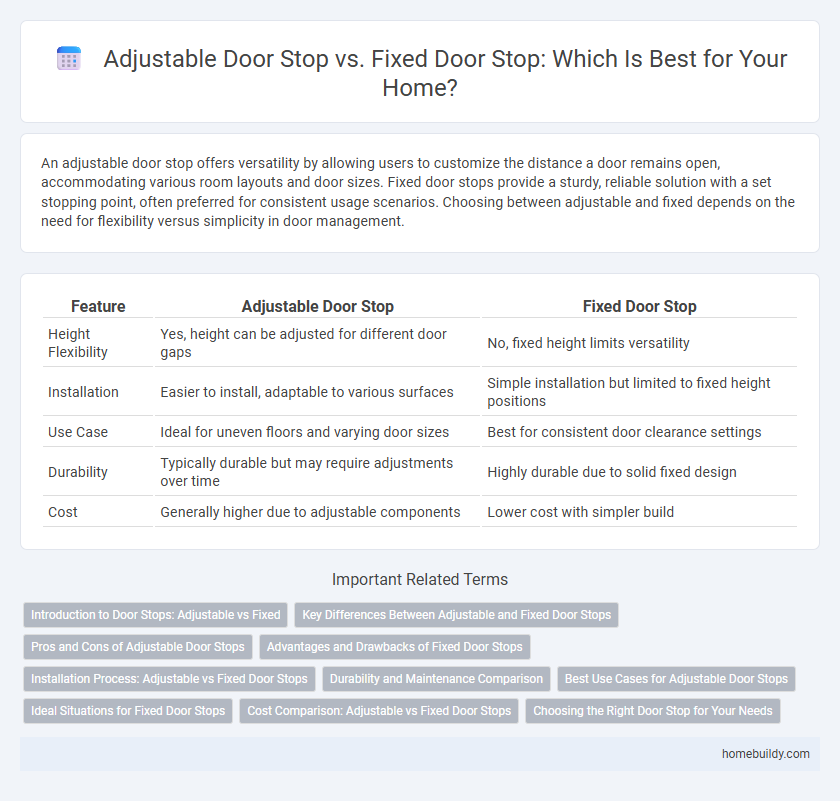An adjustable door stop offers versatility by allowing users to customize the distance a door remains open, accommodating various room layouts and door sizes. Fixed door stops provide a sturdy, reliable solution with a set stopping point, often preferred for consistent usage scenarios. Choosing between adjustable and fixed depends on the need for flexibility versus simplicity in door management.
Table of Comparison
| Feature | Adjustable Door Stop | Fixed Door Stop |
|---|---|---|
| Height Flexibility | Yes, height can be adjusted for different door gaps | No, fixed height limits versatility |
| Installation | Easier to install, adaptable to various surfaces | Simple installation but limited to fixed height positions |
| Use Case | Ideal for uneven floors and varying door sizes | Best for consistent door clearance settings |
| Durability | Typically durable but may require adjustments over time | Highly durable due to solid fixed design |
| Cost | Generally higher due to adjustable components | Lower cost with simpler build |
Introduction to Door Stops: Adjustable vs Fixed
Door stops are essential hardware designed to prevent doors from damaging walls or furnishings by limiting door movement. Adjustable door stops offer customizable positioning to accommodate varying door angles and sizes, enhancing flexibility in different spaces. Fixed door stops provide a straightforward, durable solution with a set stopping point, ideal for consistent and predictable door control.
Key Differences Between Adjustable and Fixed Door Stops
Adjustable door stops offer customizable height and angle settings, allowing for versatile placement to accommodate different door sizes and floor conditions, while fixed door stops provide a single, unchanging position for consistent use. Adjustable models typically feature mechanisms like screws or sliding components for precise control, whereas fixed stops rely on a rigid design made from materials such as rubber, metal, or plastic. The choice between adjustable and fixed door stops influences installation flexibility, durability, and the ability to protect walls and doors from impact damage effectively.
Pros and Cons of Adjustable Door Stops
Adjustable door stops offer versatile control over door positioning, allowing for precise customization to prevent damage and manage airflow, which fixed door stops lack. Their flexibility makes them suitable for various door sizes and types, but they may require occasional readjustment and can be more complex to install compared to the straightforward, durable design of fixed stops. The adaptability of adjustable stops enhances usability in dynamic environments, while fixed stops provide a low-maintenance, reliable solution for consistent door angles.
Advantages and Drawbacks of Fixed Door Stops
Fixed door stops offer reliable stability by providing a constant barrier that prevents door damage and wall marks, making them ideal for high-traffic areas requiring minimal adjustments. Their simplicity and low maintenance reduce long-term costs and installation complexity, yet their lack of flexibility can limit adaptability for varying door sizes or positioning changes. Fixed stops may also cause inconvenience in tight spaces where adjustable stops could better optimize clearance.
Installation Process: Adjustable vs Fixed Door Stops
Adjustable door stops offer a flexible installation process, allowing precise positioning to accommodate different door swing angles and floor clearances, which reduces the need for reinstallation. Fixed door stops require careful measurement and placement during installation to ensure proper functionality, often limiting their effectiveness to a single door configuration. The versatility of adjustable stops makes them suitable for various environments, while fixed stops provide a straightforward, durable solution with minimal adjustments.
Durability and Maintenance Comparison
Adjustable door stops typically feature metal components with adjustable screws, offering enhanced durability and customizable positioning that extends their lifespan under frequent use. Fixed door stops, often made from rubber or metal, require less maintenance due to their simpler design but may wear out faster when exposed to consistent impact or environmental factors. Choosing between the two depends on balancing the need for long-term durability against maintenance convenience in high-traffic areas.
Best Use Cases for Adjustable Door Stops
Adjustable door stops offer versatile solutions for varying door sizes and floor types, making them ideal for dynamic environments such as offices, classrooms, and multi-purpose rooms where door positions frequently change. Their ability to customize the stopping distance prevents damage to walls and door hardware, enhancing door longevity and reducing maintenance costs. These features make adjustable door stops the preferred choice for spaces that require flexible door control and protection.
Ideal Situations for Fixed Door Stops
Fixed door stops are ideal for high-traffic areas where consistent door positioning is essential to prevent damage to walls and furniture. Their sturdy, immovable design provides reliable resistance against heavy doors and strong impacts. Fixed stops are best suited for environments like commercial buildings or busy households where durability and stability outweigh the need for frequent adjustments.
Cost Comparison: Adjustable vs Fixed Door Stops
Adjustable door stops generally cost more than fixed door stops due to their versatile design and added functionality. Fixed door stops offer a budget-friendly option with lower upfront costs but lack the flexibility of height or angle adjustments. Investing in adjustable door stops can provide long-term savings by accommodating varying door positions and preventing damage more effectively.
Choosing the Right Door Stop for Your Needs
Selecting between an adjustable door stop and a fixed door stop depends on your specific requirements for flexibility and control. Adjustable door stops offer customizable height and positioning, making them ideal for varying door sizes and preventing damage, while fixed door stops provide a sturdy, permanent solution for consistent door angles. Understanding factors such as door weight, floor type, and desired stop precision helps determine the most effective option for your space.
Adjustable Door Stop vs Fixed Door Stop Infographic

 homebuildy.com
homebuildy.com